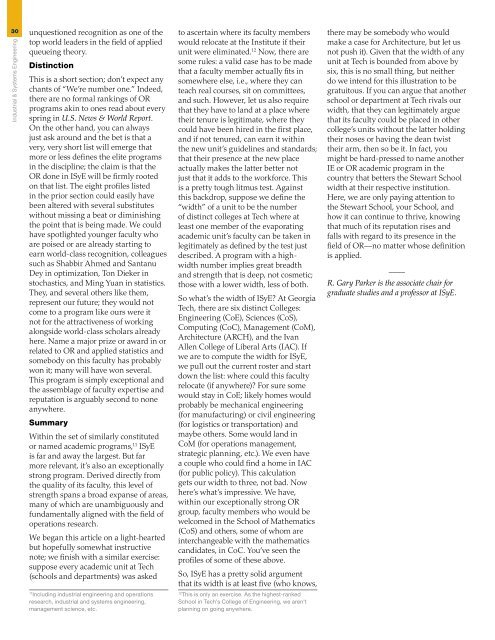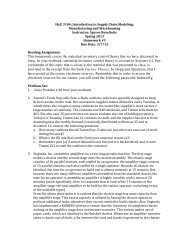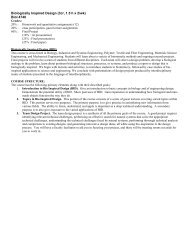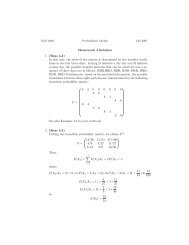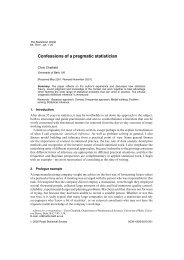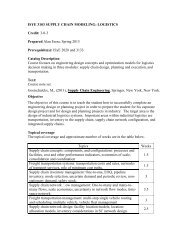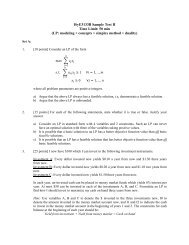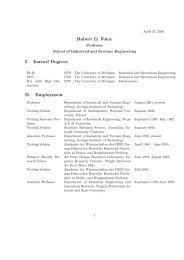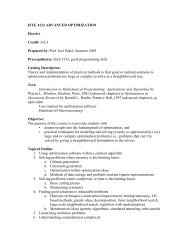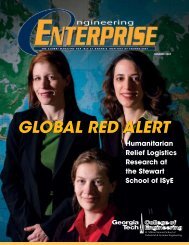Fall 2011 - H. Milton Stewart School of Industrial & Systems ...
Fall 2011 - H. Milton Stewart School of Industrial & Systems ...
Fall 2011 - H. Milton Stewart School of Industrial & Systems ...
You also want an ePaper? Increase the reach of your titles
YUMPU automatically turns print PDFs into web optimized ePapers that Google loves.
30<br />
<strong>Industrial</strong> & <strong>Systems</strong> Engineering<br />
unquestioned recognition as one <strong>of</strong> the<br />
top world leaders in the field <strong>of</strong> applied<br />
queueing theory.<br />
Distinction<br />
This is a short section; don’t expect any<br />
chants <strong>of</strong> “We’re number one.” Indeed,<br />
there are no formal rankings <strong>of</strong> OR<br />
programs akin to ones read about every<br />
spring in U.S. News & World Report.<br />
On the other hand, you can always<br />
just ask around and the bet is that a<br />
very, very short list will emerge that<br />
more or less defines the elite programs<br />
in the discipline; the claim is that the<br />
OR done in ISyE will be firmly rooted<br />
on that list. The eight pr<strong>of</strong>iles listed<br />
in the prior section could easily have<br />
been altered with several substitutes<br />
without missing a beat or diminishing<br />
the point that is being made. We could<br />
have spotlighted younger faculty who<br />
are poised or are already starting to<br />
earn world-class recognition, colleagues<br />
such as Shabbir Ahmed and Santanu<br />
Dey in optimization, Ton Dieker in<br />
stochastics, and Ming Yuan in statistics.<br />
They, and several others like them,<br />
represent our future; they would not<br />
come to a program like ours were it<br />
not for the attractiveness <strong>of</strong> working<br />
alongside world-class scholars already<br />
here. Name a major prize or award in or<br />
related to OR and applied statistics and<br />
somebody on this faculty has probably<br />
won it; many will have won several.<br />
This program is simply exceptional and<br />
the assemblage <strong>of</strong> faculty expertise and<br />
reputation is arguably second to none<br />
anywhere.<br />
Summary<br />
Within the set <strong>of</strong> similarly constituted<br />
or named academic programs, 11 ISyE<br />
is far and away the largest. But far<br />
more relevant, it’s also an exceptionally<br />
strong program. Derived directly from<br />
the quality <strong>of</strong> its faculty, this level <strong>of</strong><br />
strength spans a broad expanse <strong>of</strong> areas,<br />
many <strong>of</strong> which are unambiguously and<br />
fundamentally aligned with the field <strong>of</strong><br />
operations research.<br />
We began this article on a light-hearted<br />
but hopefully somewhat instructive<br />
note; we finish with a similar exercise:<br />
suppose every academic unit at Tech<br />
(schools and departments) was asked<br />
to ascertain where its faculty members<br />
would relocate at the Institute if their<br />
unit were eliminated. 12 Now, there are<br />
some rules: a valid case has to be made<br />
that a faculty member actually fits in<br />
somewhere else, i.e., where they can<br />
teach real courses, sit on committees,<br />
and such. However, let us also require<br />
that they have to land at a place where<br />
their tenure is legitimate, where they<br />
could have been hired in the first place,<br />
and if not tenured, can earn it within<br />
the new unit’s guidelines and standards;<br />
that their presence at the new place<br />
actually makes the latter better not<br />
just that it adds to the workforce. This<br />
is a pretty tough litmus test. Against<br />
this backdrop, suppose we define the<br />
“width” <strong>of</strong> a unit to be the number<br />
<strong>of</strong> distinct colleges at Tech where at<br />
least one member <strong>of</strong> the evaporating<br />
academic unit’s faculty can be taken in<br />
legitimately as defined by the test just<br />
described. A program with a highwidth<br />
number implies great breadth<br />
and strength that is deep, not cosmetic;<br />
those with a lower width, less <strong>of</strong> both.<br />
So what’s the width <strong>of</strong> ISyE At Georgia<br />
Tech, there are six distinct Colleges:<br />
Engineering (CoE), Sciences (CoS),<br />
Computing (CoC), Management (CoM),<br />
Architecture (ARCH), and the Ivan<br />
Allen College <strong>of</strong> Liberal Arts (IAC). If<br />
we are to compute the width for ISyE,<br />
we pull out the current roster and start<br />
down the list: where could this faculty<br />
relocate (if anywhere) For sure some<br />
would stay in CoE; likely homes would<br />
probably be mechanical engineering<br />
(for manufacturing) or civil engineering<br />
(for logistics or transportation) and<br />
maybe others. Some would land in<br />
CoM (for operations management,<br />
strategic planning, etc.). We even have<br />
a couple who could find a home in IAC<br />
(for public policy). This calculation<br />
gets our width to three, not bad. Now<br />
here’s what’s impressive. We have,<br />
within our exceptionally strong OR<br />
group, faculty members who would be<br />
welcomed in the <strong>School</strong> <strong>of</strong> Mathematics<br />
(CoS) and others, some <strong>of</strong> whom are<br />
interchangeable with the mathematics<br />
candidates, in CoC. You’ve seen the<br />
pr<strong>of</strong>iles <strong>of</strong> some <strong>of</strong> these above.<br />
So, ISyE has a pretty solid argument<br />
that its width is at least five (who knows,<br />
there may be somebody who would<br />
make a case for Architecture, but let us<br />
not push it). Given that the width <strong>of</strong> any<br />
unit at Tech is bounded from above by<br />
six, this is no small thing, but neither<br />
do we intend for this illustration to be<br />
gratuitous. If you can argue that another<br />
school or department at Tech rivals our<br />
width, that they can legitimately argue<br />
that its faculty could be placed in other<br />
college’s units without the latter holding<br />
their noses or having the dean twist<br />
their arm, then so be it. In fact, you<br />
might be hard-pressed to name another<br />
IE or OR academic program in the<br />
country that betters the <strong>Stewart</strong> <strong>School</strong><br />
width at their respective institution.<br />
Here, we are only paying attention to<br />
the <strong>Stewart</strong> <strong>School</strong>, your <strong>School</strong>, and<br />
how it can continue to thrive, knowing<br />
that much <strong>of</strong> its reputation rises and<br />
falls with regard to its presence in the<br />
field <strong>of</strong> OR—no matter whose definition<br />
is applied.<br />
____<br />
R. Gary Parker is the associate chair for<br />
graduate studies and a pr<strong>of</strong>essor at ISyE.<br />
11<br />
Including industrial engineering and operations<br />
research, industrial and systems engineering,<br />
management science, etc.<br />
12<br />
This is only an exercise. As the highest-ranked<br />
<strong>School</strong> in Tech’s College <strong>of</strong> Engineering, we aren’t<br />
planning on going anywhere.


